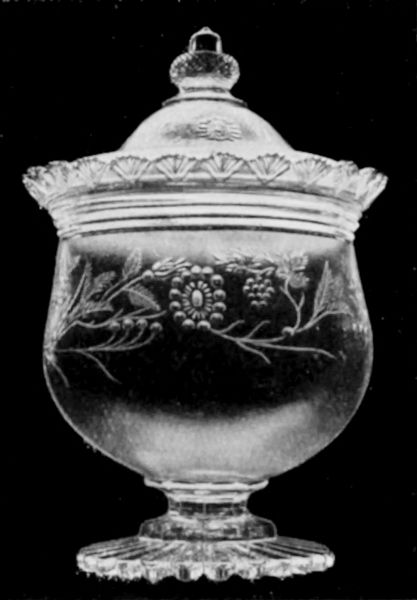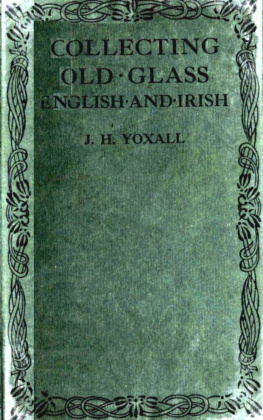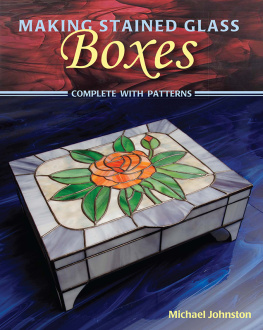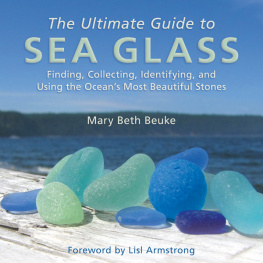Table of Contents
THE COLLECTORS POCKET SERIES
EDITED BY SIR JAMES YOXALL, M.P.
COLLECTING
OLD GLASS
COLLECTING
OLD GLASS
ENGLISH AND IRISH
BY J. H. YOXALL
Author of The Wander Years The A B C
about Collecting More about Collecting
The glass of fashion and the mould of form: Hamlet, iii. 1
PREFACE
I hope the reader may find that this book, though smaller than others on the same subject, is more helpful and even more comprehensive than they are; that it deals with the glass articles which they mention and with others which they omit; that it simplifies and classifies the study and practice of glass-collecting more than has been done in print heretofore; and that it can do these things because it is written out of personal knowledge, gained from much experience, and not from hearsay or from other books.
Diffuseness has been avoided, but this, I hope, has enabled me to make the book the more lucid, as well as the more succinct. At any rate, it affords hints, general rules, and warnings more numerous and more practical than any published until now; I have also tried to give to it a quality which reviewers have found present in my other books on Collectingthat is, a simplicity and clearness of explanation, done at the most difficult and necessary points, and in an interesting way. Moreover, this book has had the great advantage of revision (before printing) by Mr. G. F. Collins, of 53 the Lanes, Brighton, a pupil of Mr. Hartshornes, and well known to all principal collectors of old glass. Most of the illustrations represent typical pieces in my own collection, but for some of the finest I have to thank the kindness of Mrs. Devitt, of Herontye, East Grinstead, a collector indeed. The illustrations do not represent relative sizes to the same scale.
J. H. YOXALL
I. OLD ENGLISH GLASSWARE
T he glassware made in England and Ireland during the eighteenth and part of the nineteenth century was the best of the kind ever made. In quality, tint, feel, and ring the plain blown glass was a beautiful product, and when it was cut or engraved the decoration was done by fine craftsmen and often with excellent taste. Old glass has its own peculiar charm; the dark beauty of the crystal metal, the variety of form, the bell-like ring when flipped, the satiny feeling of the surface, the sparkle of the cut facets, and the combination of gracefulness and usefulness attract a collector: in cabinets it shines, gleams, glows, and sparkles in a reticent, well-bred way.

(1) MOULDED; (2) COTTON-WHITE; (3) CUT KNOPPED; AND (4) CUT AND MOULDED CAPTAIN GLASSES
Then there is attraction in the historical and social traditions which have gathered around the ware; romance lingers on in the Jacobite glasses, the Williamite glasses, the Georgian glasses, the rummers and groggers engraved and drunk from to celebrate the victories of Nelson or famous elections; and humour resides in many of the relics of the punch-bowl and six-bottle days. To honour particular occasions ones fine old glasses may come out of the cabinet and be used at table again; I know a collector of captain glasses who brings them out for champagne. For decoration or in use old glass has a refined, artistic, aristocratic air.
NEITHER TOO RARE NOR TOO PLENTIFUL
The sound of the past seems to throb in the ring of this frail and dainty ware; at your touch the cry of the bygone seems heard again. Because of fragility, enough of eighteenth-century glass has not lasted on to make it common, and yet so much of it is still extant that a collectors hunt for it is by no means a hopeless quest. It may still be acquired at reasonable prices from dealers in antiques, and a hunter for it in odd corners, who buys in shillings, not in pounds, may reasonably hope to pick up many fine specimens for next to nothing even yet. Four years ago I bought a fine drawn cordial glass for 2d. Within the past three years I have myself bought a perfect captain glass for 3s. 6d.; within the last year I have bought six punch-lifters for 17s. 6d. in all, uncommon as these bibulous old siphons are. A large Bristol coloured-glass paper-weight may cost you 3 in a dealers shop, because three years ago they began to be a rage, but within the past two years I have bought a Bristol glass article, equally beautiful in colour and glass-flowers, and much rarer, for 2s. Footless coaching glasses and thistle-shaped fuddling glasses are seldom seen, even on a dealers shelves, but I have found one of each, in odd corners, for 6d.
THE TIME TO COLLECT IS NOW

WATERFORD GLASS ENGRAVED AND CUT: NOTE THE FANLIKE EDGING AND THE STAR CUT TO EDGE OF BASE; ALSO THE DEEP CUTTING OF THE FLORAL ORNAMENT
Now, if ever, is the time to collect old glass rather cheaply, for already the prices of it are mounting in a remarkable way. Thirty years ago old wine glasses engraved with roses, rosebuds, and butterfliesrose glasses, as they are calledcould be bought for half-a-crown apiece or lessdozens of them; this price has multiplied nearly twentyfold. Waterford cut-glass grows more and more dear to buy, from dealers who know it when they possess itthey will soon be selling it as if it were antique silver, at so much per ouncebut only last year I bought in a provincial town a captain glass of this ware for 15s., though 8 was the price asked for one just like it in the West End. Now, if ever, is the time for a beginner to take up this line of collecting; old English and Irish glass will never again be so easy to find at reasonable prices as it is now.
SUCH CONNOISSEURSHIP NOT DIFFICULT
Collecting is a form of education, but it is not difficult to become a knowledgeable collector of old glass. Counterfeits are sent out by the thousand, forgeries lie in wait, totally new glassware, imitative of the old, is on sale in hundreds of curio dealers shops, some of them otherwise honest and respectable; but only ignorance or carelessness need be taken in. A little study, a little observation, a little care, and the beginner will soon be able to avoid mistakes. Connoisseurship in old glass is less difficult than it is in old china, for example; porcelain or earthenware collecting is more various, more detailed, has reference to longer periods of manufacture, and involves much more specific knowledge than glass-collecting does. Yet I have known two or three collectors of porcelain who declined to begin collecting old glass because, they said, they would never dareas if an almost miraculous skill were needed to become a connoisseur in old glass! In point of fact, this is the easiest hobby to study and know; glass-collecting requires an eye for the different shades and tints of the metal, a finger-tip for the feel of it, an ear for the ring of it, and not much money as yet, and practically that is all. There are no trade-marks to puzzle or deceive you; there is no such distinction, difficult to understand and master, as between soft china and hard. At present old glass is easy to know, and not difficult to find.
I propose in this book to give general hints, tips, and instructions applicable to every variety of old glass; to explain the seven principal tests of genuine age and antique make; to prepare the beginner to go out collecting glass with the infallible rules and principles for it fixed in his mind. Equipped with these, anyone may examine, test, and if satisfactory buy any vessel of glass which he or she may find in any odd corner. I am not writing the book for the rich, but for people with more taste and cultivation than money, and though I deprecate collecting for the sake of selling again at a profit, I may well point out that old English and Irish glass, bought cheaply now, may become an investment













